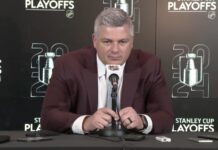Teams rarely, if ever, receive a substantial enough, or even on-par, return for elite athletes. The Phil Kessel case is no different.
A club’s desire to maximize asset return hinges on the prevalence of control. Often, trading elite athletes is more about recouping value for an expiring asset (expiring by contract or a need to part ways). Maximizing assets means taking advantage of a coveted piece to increase bargaining power, whether by creating bidding war or fleecing a needy General Manager; generally dictating terms and conditions.
I don’t think the Leafs were in this position from the onset. At all. They dealt from a position of weakness that limited the return.
Nothing is done without this one key point:
The decision to move on from Kessel this summer was finalized within Leafs management whether the Leafs or Kessel made that decision. Any talk about bringing Kessel back next season was empty rhetoric. Sean McIndoe made this point in his Grantland expansion.
That decision, already made, drove this process. Regardless of the validity or merit of trading your best asset, clearly they had to in order to move forward.
This is what I think happened:
Toronto received 29 friendly calls from other teams, perhaps a 30th, an internal, unheeded background whisper making the plea to keep Kessel.
Of the 29 (the 30th drowned out entirely) maybe a handful sent low-ball offers to counter Toronto’s high demands, ultimately trying to find some common middle ground. The handful likely shrunk, leaving Pittsburgh as the only suitor.
That’s the point it morphed from maximizing a coveted asset to recouping value; trying to nab any potential asset rather than leveraging a hardline stance to drive up the price. Pittsburgh’s offer was likeliest the best they could entertain and it was molded and shaped into what it became on July 1.
Pens GM Rutherford indicated on TSN of a limited time frame as well – free agency – in order to move on, that heightened the sense of urgency to get a deal done.
If the Leafs were truly willing to go into next season with their best asset to try to trade at another time, this is where they walk away from the negotiation table. They didn’t, they proceeded.
They recouped whatever they could get with hopes of developing the return into proper NHL assets, a sentiment echoed by both Brendan Shanahan and Kyle Dubas putting faith into ‘the program.’
Kyle Dubas had mentioned they liked Kasperi Kapanen in the baby Penguins playoffs during his free agency media scrum. That could possibly mean Pittsburgh was their lone serious trade partner all along (with some minor nibbles).
Or, they made that decision based on amateur scouting familiarity and some pro scouting and information from those familiar to the Finn. It’s unlikely they caught every game live; it was likely a combo of live viewings and video supplemented by amateur scouting reports.
Regardless, that’s a small sample of views, but when you’re recouping assets, you take what you can get.
They didn’t have a choice.
Asset Replenishment
The rest of free agency played out exactly as if right out of Moneyball, betting on undervalued assets to turn into viable tradeable pieces in the future; the likes of Hunwick, Parenteau and returnee Daniel Winnik all fall into that category.
I would call this an asset replenishment strategy with a supplemental derivative benefit. Signing players to be flipped for picks or prospects is clearly beneficial for a team requiring any and all, skilled, undeveloped talent at it’s disposal. As a collective, the signees don’t amount to much aside from specific roles on a fledgling team, but the individual parts bear a value with very little to zero risk. Found wallets.
This is the same philosophy I applied to the Leafs draft. As a collective they likely don’t all turn into assets. Half may never play an NHL game, but individually by drafting skilled, individually desirable players, taking full advantage of a market inefficiency in undersized skilled players, they all have potential future asset value. The flexibility in either case is a desirable offshoot of the current process.
Currently, I think they are building an asset replenishment system using this model – that has a self sustaining mechanism at some point, requiring less resources to maintain with success, while taking other measures to further refine ‘the program’. Hiring a Director of Sports Science Jeremy Bettle in addition to adding Darryl Belfry for skills development; that’s in addition to a revamped Toronto Marlies coaching staff.
Add a functional analytics department, not only focused in on-ice events, but with the bigger picture in mind. There’s an added benefit of having Cam Charron who already possesses knowledgeable background in fitness, and the plan starts to take shape.
Gus Katsaros is the Director of Analytics and Pro Scouting for McKeen’s Hockey. Follow on Twitter @KatsHockey

































